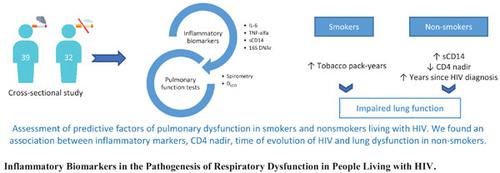Current HIV Research ( IF 1 ) Pub Date : 2021-08-31 , DOI: 10.2174/1570162x19666210607103157 Isabel Ribes 1 , Sergio Reus 1 , Santos Asensio 2 , Mar García-Ródenas 2 , Rafael León 1 , Irene Portilla-Tamarit 1 , Livia Giner 1 , Joaquín Portilla 1

|
Background: Although the association between HIV infection and airways obstruction is well known, its etiopathogenesis is not clear.
Objectives: Our aim was to analyze the association between biomarkers of systemic inflammation and bacterial translocation and pulmonary function tests in HIV infected patients and compare it between smokers and non-smokers.
Methods: Cross-sectional, observational study. Inclusion criteria: people living with HIV with undetectable plasma viral load. Exclusion criteria: other comorbidities associated with systemic inflammation. Outcome variables: spirometry and diffusing capacity for carbon monoxide; explanatory variables: inflammatory biomarkers (interleukin-6, tumor necrosis factor-alpha), bacterial translocation (soluble CD14 [sCD14] and bacterial 16S rDNA), and variables related to HIV infection. Associations were tested using the Pearson/Spearman correlation tests, the student t test, and multivariable linear regression.
Results: We included 71 patients (54.9% smokers). We did not observe significant differences in pulmonary function tests according to biomarkers of inflammation or bacterial translocation. In non-smokers (n=32), sCD14 was negatively correlated with forced expiratory volume in 1 second (R = -0.35, P = 0.048) and forced vital capacity (R= -0.40, P=0.023). Age, time since HIV diagnosis and CD4+ nadir were associated with alterations in PFTs. In smokers, the only association observed was between the pack-years and pulmonary obstruction.
Conclusions: In non-smokers HIV patients, lung dysfunction can be, at least partially, related to bacterial translocation (sCD14), CD4+ nadir and time since HIV diagnosis.
中文翻译:

HIV感染者呼吸功能障碍发病机制中的炎症生物标志物
背景:虽然 HIV 感染与气道阻塞之间的关联是众所周知的,但其发病机制尚不清楚。
目的:我们的目的是分析全身炎症的生物标志物与 HIV 感染患者的细菌易位和肺功能测试之间的关联,并在吸烟者和非吸烟者之间进行比较。
方法:横断面观察研究。纳入标准:血浆病毒载量检测不到的 HIV 感染者。排除标准:与全身炎症相关的其他合并症。结果变量:肺活量测定和一氧化碳扩散能力;解释变量:炎症生物标志物(白细胞介素 6、肿瘤坏死因子 α)、细菌易位(可溶性 CD14 [sCD14] 和细菌 16S rDNA)以及与 HIV 感染相关的变量。使用 Pearson/Spearman 相关性检验、学生 t 检验和多变量线性回归来测试关联。
结果:我们纳入了 71 名患者(54.9% 的吸烟者)。根据炎症或细菌易位的生物标志物,我们没有观察到肺功能测试的显着差异。在非吸烟者 (n=32) 中,sCD14 与 1 秒用力呼气量 (R = -0.35, P = 0.048) 和用力肺活量 (R= -0.40, P=0.023) 呈负相关。年龄、自 HIV 诊断以来的时间和 CD4+ 最低点与 PFT 的改变有关。在吸烟者中,观察到的唯一关联是包年数和肺阻塞之间。
结论:在非吸烟 HIV 患者中,肺功能障碍可能至少部分与细菌易位 (sCD14)、CD4+ 最低点和 HIV 诊断后的时间有关。


























 京公网安备 11010802027423号
京公网安备 11010802027423号